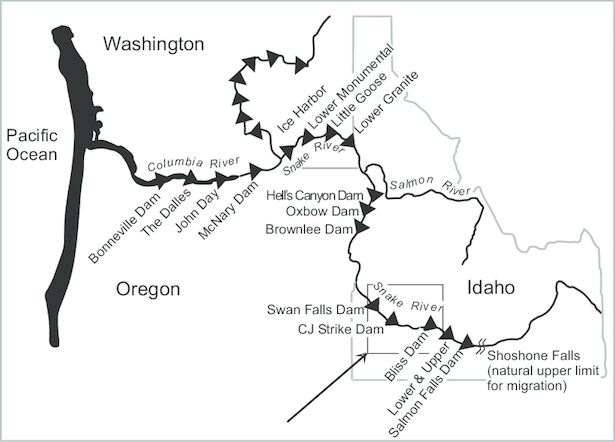Q.
Are there dams above the LSR and how does that effect the recovery of Chinook?

A.
Yes, see discussion of Hells Canyon Complex in the previous question.
To access the largest wilderness in the lower 48 states, there are no further dams beyond Lower Granite Dam whose reservoir extends to the Idaho border and a 4.6 miles up the Clearwater River at Lewiston, Idaho. The Salmon River is the longest river system contained entirely within a single U.S. state.
On the North Fork of the Clearwater River:
- Dworshak Dam, completed in 1973, four miles northwest of Orofino, Idaho.
Further South, there is a long history of dams blocking upstream passage to the Upper Snake River. Before the construction of Idaho Power's Hells Canyon dam complex, Fall Chinook had access 371 more miles of the -- and a multitude of tributaries -- extending up to the 100-foot tall Shoshone Falls near Twin Falls, Idaho. (from NW Power Council Salmon and Steelhead Losses in the Columbia River Basin, Table 15).
On the Snake River, upstream of the Salmon River conflucene are these Idaho Power dams:
- Hells Canyon Dam, completed in 1967, at river mile 251
- Oxbow Dam, completed in 1961, at river mile 272
- Brownlee Dam, completed in 1958, at river mile 285.0
- Swan Falls Dam, completed in 1901, at river mile 457.7
- C. J. Strike Dam, completed in 1952, at river mile 494.0
- Bliss Dam, completed in 1950, at river mile 560.3
- Upper Salmon Falls, completed in 1968, at river mile 580.8
- Lower Salmon Falls, completed in 1910, at river mile 573.0
- Shoshone Falls Dam, completed in 1907, at river mile 614.7

Shoshone Falls at 212 feet in height has always been an impassable barrier to salmon migration.
- Black Canyon Diversion Dam on the Payette River, completed in 1924 blocked migration of Salmon.
- Owyhee Dam on the Owyhee River, completed in 1932 blocked migration of Salmon.
- Owyhee Dam on the Boise River, completed in 1906 blocked migration of Salmon.
- Twin Falls Dam, completed in 1935, river mile 617.4
- Milner Dam, completed in 1905, at river mile 639.1
- Minidoka Dam, completed in 1906, at river mile 740 (approximate)
- American Falls Dam, completed in 1978, at river mile 714.7
- Gem State Dam, completed in 1988, at river mile 785 (approximate)
- Palisades Dam, completed in 1957, at river mile 845 (approximate)
- Jackson Lake Dam, completed in 1916, at river mile 980 (approximate)
Breaching is reversible, extinction and ecosystem collapse is not.
The concept of sustainability has been increasingly brought into focus as we have become convinced that all systems on earth are interrelated and that many of today’s problems were the solutions of yesterday. Sustainability is, however, a very old concept. Most American Indian cultures understood the importance of sustainability and sustainable development, living in harmony with all things.
Many people are familiar with the Seventh Generation philosophy commonly credited to the Iroquois Confederacy but practiced by many Native nations. The Seventh Generation philosophy mandated that tribal decision makers consider the effects of their actions and decisions for descendents seven generations into the future. There was a clear understanding that everything we do has consequences for something and someone else, reminding us that we are all ultimately connected to creation.



